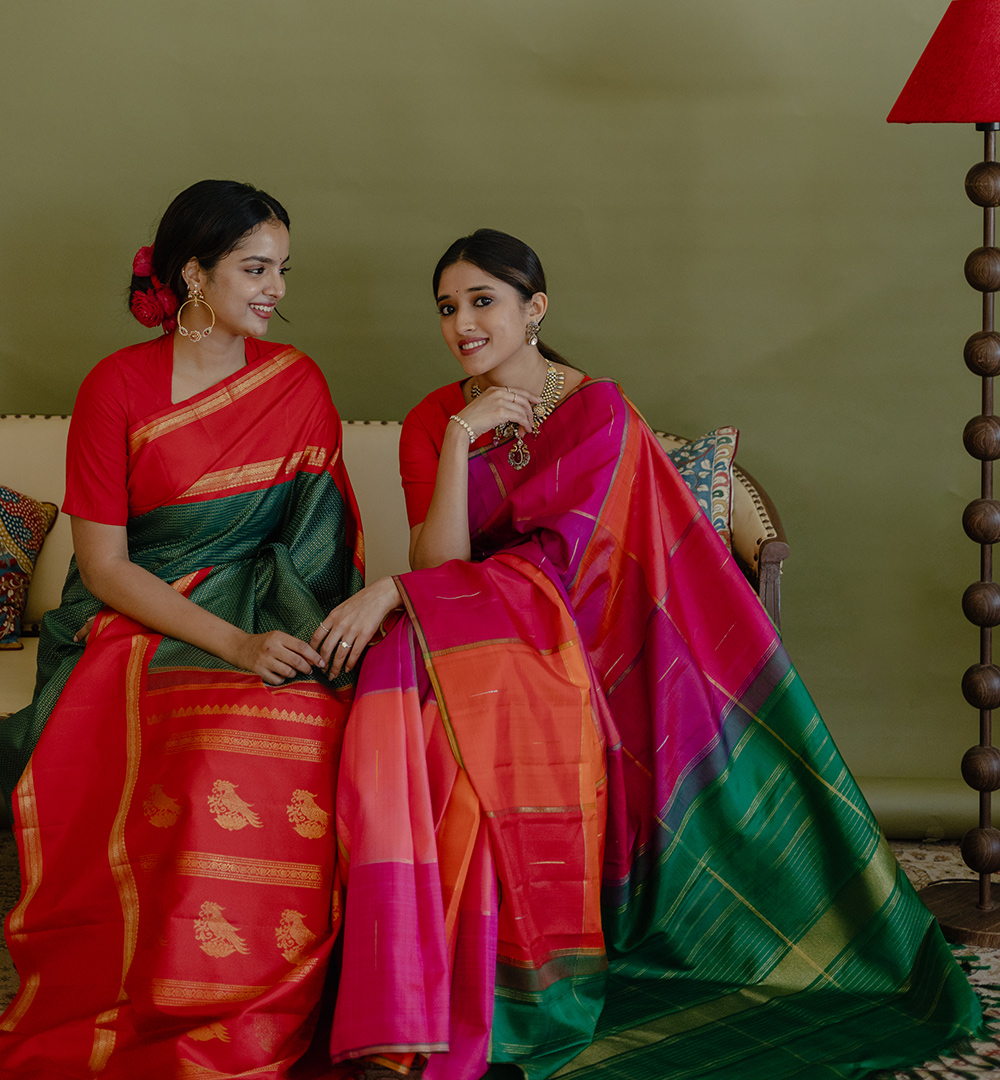The Journey of a Bridal Saree: A Story of Loom and Love
Every Indian bride has stood before a mirror, her mother's saree draped imperfectly around her, heart fluttering as she glimpses her future self. The vibrant rich fabric against her skin tone, the weight of generations on her shoulders - these moments embed themselves in her soul long before the wedding day arrives. A bridal saree isn’t just worn; it’s felt, lived, and cherished. The search for the perfect saree is a journey of emotion and instinct. She moves through bustling markets, fingertips tracing fabrics and colours until she finds it - the one that feels like home!
In this blog, we explore the journey of a bridal saree from the hands of master weavers to its final moment, draped in love and tradition.
The Artisanal Journey Begins
The journey of a bridal saree begins long before a bride ever lays eyes on it for her special day. India’s handloom industry, the second-largest employer after agriculture, sustains over 3.6 million artisans who devote their lives to weaving. Through their craft, they transform mere threads into symbols of elegance, culture, and pride.
In small village workshops, under the warm glow of oil lamps or soft morning light, artisans prepare their looms. With practised hands, they stretch delicate warp threads onto wooden frames, moving with the precision of a sacred ritual. Each saree’s creation is as intricate as its patterns, requiring patience, expertise, and an unbroken lineage of craftsmanship.
While a standard saree takes around eight days to weave, the most coveted varieties demand much more time and effort.
- Kanchipuram Silk Sarees: Crafted over one to two weeks, these opulent sarees require three to four artisans on a single loom. Elaborate zari and temple border designs may take longer.
- Banarasi Sarees: The weaving duration varies significantly based on design complexity. Simpler designs typically require around four days and the effort of three artisans. In contrast, more intricate brocades featuring elaborate zari work can extend up to six months, involving the dedicated craftsmanship of multiple skilled weavers.
- Paithani Sarees: Preparation takes four to five days, with weaving progressing just a few inches per day. A complete saree takes at least three months, while intricate versions may require a year.
- Patola Sarees: Known for double-ikat weaving, these sarees take 4-6 months on average, with complex designs demanding even more time due to precise dyeing and weaving.
Regional Traditions and Narratives
India’s saree traditions are shaped by its geography and sustained by generations of weavers. These sarees blend tradition and modernity, embodying both the heritage and evolving tastes of modern brides, each reflecting the essence of its homeland.
Kanchipuram Silk Sarees
Woven in Tamil Nadu’s temple town, Kanchipuram sarees reflect divine heritage and South Indian architectural grandeur. Rooted in mythology, these luminous silks with temple borders and sacred motifs are passed down through generations, carrying blessings and tradition.
From the sacred city of Varanasi, Banarasi silk sarees embody Mughal artistry with intricate floral jaals and shimmering zari work. Worn by brides for centuries, they are not just attire but investments in tradition, prosperity, and timeless elegance.
Handwoven in Gujarat’s Patan, Patola sarees are double-ikat masterpieces requiring mathematical precision and months of labour. Their geometric patterns symbolize fertility, prosperity, and protection.
Crafted in Maharashtra’s Paithan, Paithani sarees shimmer with peacock blues and golden hues, once reserved for royalty. The peacock and lotus motifs symbolize prosperity and fertility, making them treasured bridal heirlooms. Families save for years to gift these sarees, knowing they carry the strength of tradition and the grace of queens.
The Transformation into a Bridal Masterpiece
Yarn: The First Blessing
The journey begins with mulberry silk, bathed in rice water and sun-kissed for strength. Twisted into Murukku Pattu, these threads gain the resilience that defines Kanchipuram sarees.
Weaving: A Prayer in Motion
Looms echo with the rhythm of devotion. The Korvai technique unites contrasting borders, mirroring the union of two families. A Jamdani weaver interlaces delicate motifs, and a Patola artisan spends months perfecting double-ikat precision.
Folding: A Ritual of Preservation
Once woven, the saree is folded with precision, ensuring motifs align perfectly when draped. Beyond storage, this act preserves ancestral blessings, ensuring the saree reaches its bride as a tangible link between past traditions and future promises.
Design & Embellishments: The Language of Blessings
In its final stage, the saree becomes a tapestry of heritage. Temple spires on Kanchipuram silks invoke protection, peacocks on Paithani pallus promise joy, and butis in Jamdani hold ancestral blessings.
The Luxury of Tulsi Madras
At Tulsi Madras, ancient tradition blossoms into contemporary elegance, especially during India's cherished summer wedding season. From spring through August, when auspicious dates fill calendars with special occasions, and religious ceremonies and families gather to celebrate unions, our collection of handcrafted Kanchipuram silk sarees becomes the centrepiece of bridal dreams.
Experience the emotion and luxurious feel of handcrafted bridal sarees at Tulsi Madras and become part of a rich tradition that weaves love into every thread.
Visit our collection today and find the saree that will tell your unique story.



